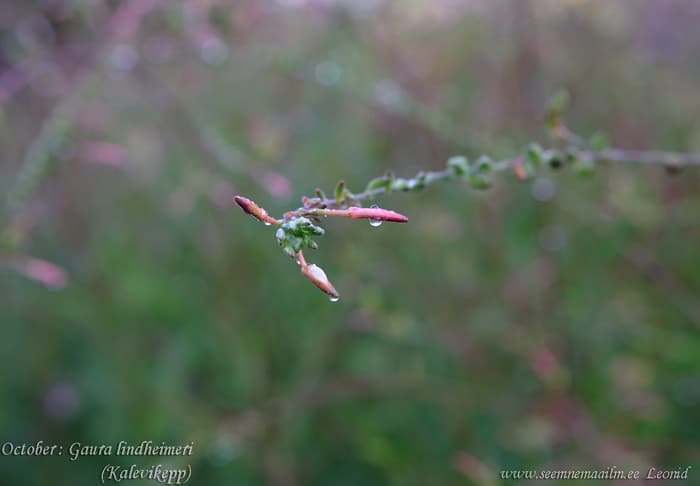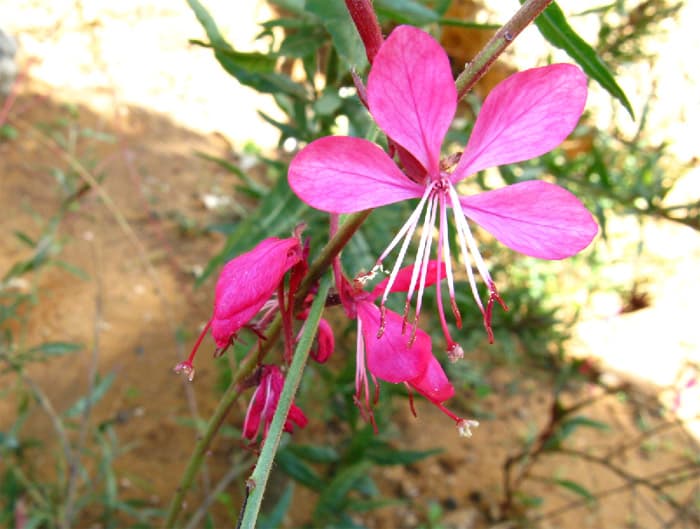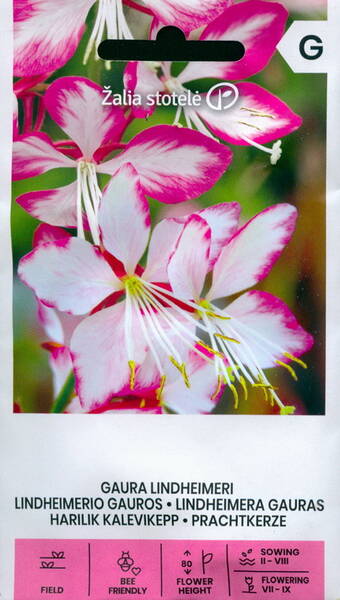Your shopping cart is empty!
Gaura lindheimeri (Lindheimer's Beeblossom)
Lindheimer's Beeblossom - Gaura lindheimeri.
Perennial, 80 cm high openwork flower with beautiful inflorescences. Blooms from July to September. Bushy, compact plant.
As a border plant with lower crops, for example, petunia, sage, etc. When cut into a vase, all flower buds open.
It is recommended to cover for the winter, the plant will freeze in cold winter.
Agricultural technology: the plant is heat-loving, prefers a sunny place, the soil is quite fertile and well-drained. Seeds are sown for seedlings in mid-March in moist compost, lightly pressing into the ground, but not falling asleep. The crops are covered with glass or film and shaded with paper. Shoots appear in 21-28 days. Constant humidity and temperature are maintained throughout. +10+16°С. After the shoots emerge, the glass and paper are removed, and when the first true leaf develops, they are planted in pots. Planted in the ground at the end of frost at a distance of 35-45 cm.
Description: the gaura genus includes 25 species, distributed in the south and middle part of North America. In culture since 1850
There are two known species, but Lindheimer's Gaura is more common.
This perennial, erect, highly branched plant, 60-120 cm high, is grown as an annual plant in temperate climates. The lower leaves are pinnately dissected, jagged at the edges and wavy at the ends, the upper ones are entire. All parts of the plant are slightly pubescent. The flowers are funnel-shaped with an elongated tube and bent perianth lobes, white or pinkish, collected in a long raceme. Flowering lasts from July to autumn. The seeds are large, oval, with deep grooves, light brown, 1 g contains 60-65 pieces. Germination lasts for at least three years.
Location: a warm, sunny place in the garden is allocated for planting
Soil: requires areas with fairly fertile, but not fatty or soggy soils. In years with excess humidity, gaura blooms poorly.
Perennial, 80 cm high openwork flower with beautiful inflorescences. Blooms from July to September. Bushy, compact plant.
As a border plant with lower crops, for example, petunia, sage, etc. When cut into a vase, all flower buds open.
It is recommended to cover for the winter, the plant will freeze in cold winter.
Agricultural technology: the plant is heat-loving, prefers a sunny place, the soil is quite fertile and well-drained. Seeds are sown for seedlings in mid-March in moist compost, lightly pressing into the ground, but not falling asleep. The crops are covered with glass or film and shaded with paper. Shoots appear in 21-28 days. Constant humidity and temperature are maintained throughout. +10+16°С. After the shoots emerge, the glass and paper are removed, and when the first true leaf develops, they are planted in pots. Planted in the ground at the end of frost at a distance of 35-45 cm.
Description: the gaura genus includes 25 species, distributed in the south and middle part of North America. In culture since 1850
There are two known species, but Lindheimer's Gaura is more common.
This perennial, erect, highly branched plant, 60-120 cm high, is grown as an annual plant in temperate climates. The lower leaves are pinnately dissected, jagged at the edges and wavy at the ends, the upper ones are entire. All parts of the plant are slightly pubescent. The flowers are funnel-shaped with an elongated tube and bent perianth lobes, white or pinkish, collected in a long raceme. Flowering lasts from July to autumn. The seeds are large, oval, with deep grooves, light brown, 1 g contains 60-65 pieces. Germination lasts for at least three years.
Location: a warm, sunny place in the garden is allocated for planting
Soil: requires areas with fairly fertile, but not fatty or soggy soils. In years with excess humidity, gaura blooms poorly.


Bot. syn.: Gaura filiformis var. munzii Cory, Oenothera lindheimeri (Engelm. et A. Gray).












